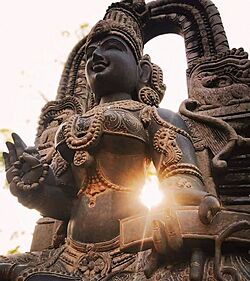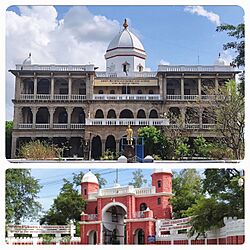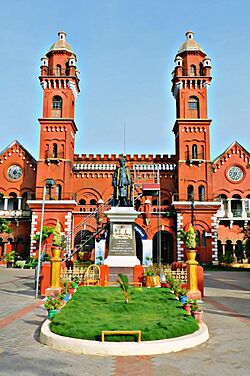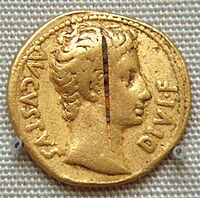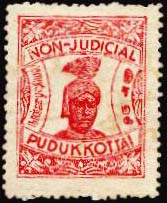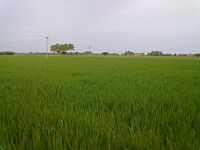Pudukkottai facts for kids
Quick facts for kids
Pudukkottai
Heritage and Historical City of Tamilnadu
|
|
|---|---|
|
City Corporation
|
|
|
1)Tamil Goddess Statue, Sittannavasal, 2)District Collector Office, Pudukkottai; 3)District Court, Pudukkottai, 4) Sittannavasal Cave Temple, 5)Thirumayam Fort.
|
|
| Nickname(s):
pudugai , Thondaiman Pudukkottai
|
|
| Country | |
| State | |
| District | Pudukkottai |
| Collector | Mrs. M.Aruna, I.A.S |
| Superintendent of Police | Vandita Pandey, IPS |
| Government | |
| • Type | Municipal Corporation |
| • Body | Pudukkottai City Municipal Corporation |
| Area | |
| • Total | 121.26 km2 (46.82 sq mi) |
| Elevation | 116 m (381 ft) |
| Population
(2024)
|
|
| • Total | 225,500 |
| • Density | 1,859.6/km2 (4,816.4/sq mi) |
| Demonym(s) | Pudukkottaikaran |
| Languages | |
| • Official | Tamil |
| Time zone | UTC+5:30 (IST) |
| PIN |
622001 - 622006
|
| Telephone code | 04322 |
| Vehicle registration | TN-55 |
| Sex ratio | 995 per 1,000 males ♂/♀ |
Pudukkottai City is the administrative headquarters of Pudukkottai district in the Indian state of Tamil Nadu. It is one of the oldest and Heritage city in India which contains a lot of histories. The city is also called as Thondaiman Pudukkottai. Pudukottai Municipal Corporation is located on the banks of the Vellar River. It has been ruled, at different times, by the Mutharaiyar dynasty, Cholas, Early Pandyas, Thondaimans, and the British. It is situated about 372 kilometres (231 mi) southwest of the state capital Chennai,50 kilometres (31 mi) southeast of Tiruchirappalli, 60 kilometres (37 mi) southwest of Thanjavur ,108 kilometres (67 mi) northeast of Madurai,116 kilometres (72 mi) East of Dindigul and 78 kilometres (48 mi) Northeast of Sivaganga. Tamil Nadu's first woman Asian Games competitor, Santhi Soundarajan, is from Pudukkottai.
Pudukkottai is called as city of cradle of archeology. Being the district headquarters, Pudukkottai has district administrative offices, besides government educational institutes, colleges, and schools. Pudukkottai is a part of the Pudukkottai constituency and elects its member to the legislative assembly every five years; and is a part of the Lok Sabha constituency comprising Ramanathapuram, Sivaganga, Tiruchirappalli and Karur. The city is administered by a selection-grade municipality established in 1912 as per the Municipal Corporation Act. Pudukkottai covers an area of 21.25 km2 (8.20 sq mi) and had a population of 117,745 in 2011. Roadways are the major mode of transport to the city, while it has also got rail connectivity. The nearest airport is Tiruchirappalli International Airport, located at a distance of 45 km (28 miles) from the city.
It is one of the few towns and cities in List of AMRUT Smart cities in Tamil Nadu selected for AMRUT Schemes from central government and the developmental activities are taken care by government of Tamil Nadu. On 15 March 2024, the Government of Tamil Nadu announced that the town along with the surrounding merged panchayats will be upgraded from municipality to corporation status (Tamil: மாநகராட்சி).
Contents
History
The princely state of Pudukottai was created by Ragunatha Kilavan Sethupati of Ramnad (1673–1708 A.D.) married Kathali Nachiar, the sister of Raghunatha Raya Tondaiman. He appointed his brother-in-law, Ragunatha Thondaiman, as chief of the district of Pudukottai. Raghunatha Thondaiman earlier had ruled Thirumayam. In appreciation of Ragunatha Thondaiman's services, Ragunatha Kilavan Setupati gave Pudukkottai as an honor for his services. In later centuries, the Thondaiman rulers, while nominally feudatories of the Ramnad state, often pursued an independent foreign policy, a trend common in all parts of India at that time. After the death of Ragunatha Kilavan Setupati Ragunatha Thondaiman become ruler of Pudukottai.
After becoming the ruler of Pudukottai, Thonddaiman fought against the Nayaks of Thanjavur in support of the Nayaks of Madurai and conquered Thirukkattupalli, a very important place. Then there was a direct clash between the Thondaimans of Pudukottai and the Nayaks, rulers of Tanjore. Thondaiman conquered the west of Thirukkattupalli. The next ruler, Raja Vijaya Reghunatha Raya Thondaiman, helped the Arcot Nawab against Hyder Ali, the ruler of Mysore. He was also loyal to the British Government. After some time, when Hyder Ali's army tried to enter Pudukkottai, Thondaiman's army defeated them and drove Hyder's army away. Thondaiman captured Kilanilai and Aranthangi. He helped the British government against Tipu Sultan.
Pudukkotai finally came under formal British protection. This was arguably unavoidable since the Thondaimans were much menaced in that period by a resurgent Mysore, ruled by Hyder Ali and Tipu Sultan. When Tipu Sultan sought to leverage the power of the French against his British adversaries, Pudukkotai, in common with its neighbors, such as Thanjavur and Travancore, found it expedient to ally with the British.
Raja Rajagopala Thondaiman (1928–1948), the last and ninth in the line of Thondaiman rulers, was selected by the British Government and was crowned when he was six years old. After Indian independence in 1947, the Pudukkottai Princely State was amalgamated with the Indian Union on 3 April 1948 and became a division in Tiruchirappalli District. The long history of the Thondaimans' rule came to an end.
Some of the major kings of the dynasty are Tondaiman (1686–1730), Vijaya Raghunatha Raya Tondaiman,(1730–1769), Raya Raghunatha Tondaiman (1769 – Dec 1789), Vijaya Raghunatha Tondaiman (Dec 1789 – 1 February 1807), Vijaya Raghunatha Raya Tondaiman (1 February 1807 – June 1825), Raghunatha Tondaiman (June 1825 – 13 July 1839), Ramachandra Tondaiman (13 July 1839 – 15 April 1886), Marthanda Bhairava Tondaiman (15 April 1886 – 28 May 1928) and Rajagopala Tondaiman (28 October 1928 – 4 March 1948).
Pudukkottai became a princely state of British India under the political authority of Madras Presidency. The state had an area of 4663 Sq.miles and in 1901, a population of 380,000. The Rajas of Pudukkotai were entitled to a 17-gun salute. The last Thondaiman raja of Pudukkottai acceded to newly-independent India in 1948, and the state became a division of the Trichinopoly District of Madras State. The state was reorganized twice in the succeeding decade, taking its present form in 1956; it was renamed Tamil Nadu in 1968. On 14 January 1974, the present Pudukkottai District was formed from parts of Tiruchirappalli and Thanjavur districts.
Geography
Pudukkottai is located at 10°23′N 78°49′E / 10.38°N 78.82°E in the valley of the Vellar River. The city has a semi-arid climate with high temperatures throughout the year and relatively low rainfall. Pudukkottai has a plain terrain with a few rocky hills in the outskirts. Urugumalai, Athimalai, Chennaimalai are the hills that surround the city. The rivers that flow in Pudukkottai are Amaravathy, Noyal, Bhavani, and Kaveri. There are no notable mineral resources available in and around the district. Red loam and red sand are the types of soil found in the town. Paddy, groundnuts, bananas and sugarcane are the major crops in the region. Pudukkottai experiences hot and dry weather throughout the year. The temperature ranges from a maximum of 39.7 °C (103.5 °F) to a minimum of 17.8 °C (64.0 °F). Like the rest of the state, April to June are the hottest months, and December to January are the coldest. Pudukkottai receives an average rainfall of 978.8 mm (38.54 in). The Southwest monsoon, starting in June and lasting up to August, brings scanty rainfall. A bulk of the rainfall is received during the North-East monsoon in the months of October, November and December. The municipality covers an area of 21.25 km2 (21,250,000 m2).
Demographics
| Religious census | ||||
|---|---|---|---|---|
| Religion | Percent(%) | |||
| Hindu | 88.28% | |||
| Muslim | 5.86% | |||
| Christian | 6.13% | |||
| Sikh | 0.02% | |||
| Other | 0.26% | |||
| No religion | 0.26% | |||
| Historical population | ||
|---|---|---|
| Year | Pop. | ±% |
| 1961 | 50,428 | — |
| 1971 | 66,384 | +31.6% |
| 1981 | 87,952 | +32.5% |
| 1991 | 99,058 | +12.6% |
| 2001 | 109,217 | +10.3% |
| 2011 | 117,745 | +7.8% |
Sources:
|
||
According to 2011 census, Pudukkottai had a population of 117745 with a sex-ratio of 1,003 females for every 1,000 males. A total of 960 were under the age of six. The town enjoys a high literacy rate of 91.35% as of 2011 census. As of 2001, 20 slums were identified in the town and approximately 37,740 people resided in the slums. The population of the town decreased during the 1991–2001 period is attributed to the migration to other cities in search of employment and lesser job opportunities in the town. The city covers an area of 21.25 square kilometres (8.20 sq mi).
As per the religious census of 2011, Hinduism is the majority religion in Pudukkottai city with 79.40% followers. Islam is the second most popular religion in the city of Pudukkottai with approximately 15.14% following it. In Pudukkottai city, Christianity is followed by 4.89%, Jainism by 0.00%, Sikhism by 0.02%, and Buddhism by 0.02%. Around 0.04% stated 'Other Religion', approximately 0.50% stated 'No Particular Religion'.
The Thondaiman king, Vijaya Raghunatha rebuilt the town based on the principles of town planning so that the main streets were laid intersecting at right angles with the palace at the center. Out of the total area, 80.85% of the land is marked developed and 19.15% of the city remains undeveloped. Residential areas makeup 60.1% of the town's total area while commercial enterprises and industrial units make up 4.43% and 1.47% respectively. The population density is not uniform throughout the town. It is high in the center and lowers in peripheral areas such as Sivagandapuram, Ganesh Nagar, and the Tamil Nadu Housing Area. The density ranges from 200 to 300 persons per hectare in the central part of the town and 16 - 55 persons per hectare (PPH) in the peripheral areas with low-density Hindus form the majority of the urban population, followed by Muslims and Christians. Tamil is the main language spoken in the city, but the use of English is relatively common; English is the medium of instruction in most educational institutions and offices in the service sector.
Transportation
The Pudukkottai municipality maintains 122.84 km (76.33 mi) of roads. The city has 4.16 km (2.58 mi) concrete roads, 9.78 km (6.08 mi) WBM roads, 6 km (3.7 mi) gravel roads, 2.5 km (1.6 mi) footpaths and 100.4 km (62.4 mi) bituminous road. A total of 19.908 km (12.370 mi) of state highways is maintained by the State Highways Department and national highways by the National Highways Department.
There are two national highways namely the NH 336 Trichy - Ramanathapuram road and NH 36 Vikravandi - Manamadurai road that pass via Pudukkottai. There are two state highways that pass via the town - SH 26 Trichy - Mimisal road and SH 71 Musiri - Sethubavachatram road. The other major district roads connect Pudukkottai to other parts of the district. The Pudukkottai bus stand is a A-grade bus stand located in the centre of the town. The State Express Transport Corporation operates long-distance buses connecting the city to important cities like Chennai and Bengaluru. TNSTC Kumbakonam division operates frequent intercity and intrastate buses to cities like Kumbakonam, Tiruchchirapalli, Thanjavur, Madurai, Coimbatore, Aranthangi, Karaikudi, Devakottai, Sivagangai, Pattukkottai, Ponnamaravathi, Rameswaram, Kodaikanal, Dindigul, Theni, Tiruppur, Karur, Palani, Salem, Erode, Mettupalayam, Nagapattinam, Velankanni, Villupuram, Vellore, Tiruvannamalai, Nagercoil, Tiruchendur and Thoothukudi. KSRTC operates daily buses between Bengaluru and Pudukkottai.
Pudukkottai railway station has daily express trains to and from Chennai, Rameswaram and weekly express trains to Coimbatore, Puducherry, Kanyakumari, Varanasi and Bhubaneshwar. The town has passenger train services to Trichy, Manamadurai, Rameswaram and Karaikudi.
The nearest local and international airport is the Tiruchirapalli International Airport, located 45 km from the town.
Places of interest
Sittannavaasal (Ancient drawings and Stone beds).
Government Museum (This is the second largest museum of Tamil Nadu).
Thirumayam Fort.
Pudukulam (this is a large man-made tank supporting the water needs of Pudukottai town)
Pudukottai palace - A sand casket with a mantra written by saint Sadasiva Brahmendra of the 18th century is preserved. A grand palace in Pudukkottai.
Economy
The SIPCOT Industrial Complex is located on Tiruchirappalli - Rameswaram National Highways (NH 210). This Industrial complex is well connected by Road, Rail, and Air. It was established in 1980. The allotment of land commenced in 1982 to accommodate Engineering and General Industries. The total extent of complex area is 421.10 acres (1.7041 km2).
Pudukkottai district is predominantly an agricultural oriented district. Generally a dry and hot climate prevails in this district and this district's agricultural production depends mainly on the rainfall. The normal annual rainfall of the Pudukkottai district is 922.8 mm. Out of which 52.2 mm is received in winter, 124.6 mm is received in hot weather period, 351.9 mm is received during southwest Monsoon and 394.1 mm is received in North-East Monsoon. Recently Tamil Nadu Agricultural University started Diploma college in agriculture at Kudimiyanmalai with a approximate strength of 50 students including girls.
There are 5,451 irrigation tanks available in this district, of which 172 tanks were system tanks fed by Grand Anaikat Channel and the remaining are rain-fed tanks. There are about 47,583 wells in the district catering an area of 100,993 Ha. Paddy is the major crop of this district. 90000 Ha. of the area is covered under paddy, out of which 135000 Ha. of the area is fed with Kaveri Mettur Project through the G.A. canal. The remaining area is well and tank fed. The present productivity level is 4.985 Mt. of Paddy /Ha. Other than Paddy, Groundnut is the major crop in this district which is mainly cultivated under rainfed conditions. Groundnut is being cultivated in 36000 Ha. as rain fed crop and 8000 Ha. under irrigated condition. Millet, pulse, cotton, sugarcane, gingelly are the other crops cultivated in this district.
Education and utility services
As of 2011, there were 33 schools in Pudukkottai: nine primary schools, seven middle schools, and 17 high and higher secondary schools. There were three arts and science colleges, namely, H.H.The Rajah's College for men, Govt. Arts College for Women and Govt. College of Education. There were five industrial training institutes ITI in the town, namely, DIET, Govt. Industrial Technical Institute, Advanced I.T.I., Central ITI, Little flower ITI and SriBrahathambal ITI.
Electricity supply to Pudukkottai is regulated and distributed by the Tamil Nadu Electricity Board (TNEB). A Chief Distribution engineer is stationed at the regional headquarters. Water supply is provided by the Pudukkottai Municipality from the Cauvery river through Jeyapuram head water works located 86 km (53 mi) away and Ammaiyappatti water works located 9.06 km (5.63 mi). In the period 2000–2001, a total of 7 million litres of water was supplied every day for households in the town. As per the municipal data for 2011, about 30-35 metric tonnes of solid waste were collected from Pudukkottai every day by door-to-door collection and subsequently the source segregation and dumping was carried out by the sanitary department of the Pudukkottai municipality. The coverage of solid waste management in the town by the municipality had an efficiency of 100% as of 2001. There is no underground drainage system in the town and the sewerage system for disposal of sullage is through septic tanks, open drains and public conveniences.
The municipality maintained a total of 191 km (119 mi) of storm water drains in 2011: 55 km (34 mi) pucca drains and 136 km (85 mi) open drains. As of 2011, there were a total of 31 hospitals, municipal dispensary, private dispensaries and private general clinics and five clinical labs that take care of the health care needs of the citizens. As of 2011, the municipality maintained a total of 4,039 street lamps: 631 sodium lamps, 3,450 tube lights and one high mast beam lamp. The municipality operates one weekly market, two daily vegetable markets and one daily fish market that cater to the needs of the town and the rural areas around it.
Schools and colleges include:
- Agricultural College & Research Institute, Kudumiyanmalai
- Government Arts College for Women, Pudukkottai
- Government Medical College and Hospital, Pudukkottai
- H. H. The Rajah's College, Pudukkottai
- Mookambigai College of Engineering
- Mount Zion College of Engineering and Technology
- Mount Zion College of Nursing
- Valampuri Vaduganathan Higher Secondary School
- Vidyaa Vikas Higher Secondary School
Sports
There is a very famous sports club in Pudukottai called Kavinadu Sports Club. This club trains young talented athletes who are doing good in District, State, Country, and even World level sports. Two main long-distance runners that India has at the moment (2017) are Miss. Surya and Mr. Lakshmanan who have been trained in this club. Lakshmanan received gold medals for both 5,000 and 10,000 meters running in the Asian Athletic championship, 2017. He is the first person from India to win two gold medals in the Asian Athletic championship. He also took part in world championships in London, 2017, and finished the 5,000 meters heat with a personal best of 13:35.69 minutes.
See also
 In Spanish: Pudukkottai para niños
In Spanish: Pudukkottai para niños


